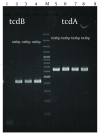Antimicrobial susceptibility of clostridium difficile clinical isolates in iran
- PMID: 24578839
- PMCID: PMC3918196
- DOI: 10.5812/ircmj.5189
Antimicrobial susceptibility of clostridium difficile clinical isolates in iran
Abstract
Background: Clostridium difficile infection (CDI) is major growing problem in hospitals and its high incidence has been reported in recent years.
Objectives: The aim of this study was to investigate the antimicrobial susceptibility patterns of C. difficile clinical isolates against antibiotics commonly used for treatment CDI in hospitalized patients.
Material and methods: During a 12 month study, 75 C. difficile isolates were collected from 390 patients with CDI. All samples were treated with alcohol and yeast extract broth. The treated suspensions were cultured on a selective cycloserine cefoxitin fructose agar (CCFA) supplemented with 5% sheep blood and incubated in anaerobic conditions, at 37 °C for 5 days. Cdd-3, tcdA and tcdB genes were identified using PCR assay.
Results: The prevalence of A(+)B(+) , A(+) B(-) and A(-) B(+) strains were 64(85.3%), 5(6.7%) and 6(8%) respectively. In vitro susceptibility of 75 clinical isolates of C. difficile to 5 antimicrobial agents, including metronidazole, vancomycin, clindamycin, erythromycin and cefotaxime were investigated by Clinical and Laboratory Standards Institute (CLSI) agar dilution method. Metronidazole and vancomycin had good activity against C. difficile isolates with MIC90s of 2 and 1 µg/ml, respectively. Seventy one (94.6%) of strains was inhibited by concentrations that did not exceed 2µg/ml for metronidazole. Resistant to metronidazole observed in 5.3% of isolates. Forty three (57.3%) of the isolates were resistant to erythromycin. Of 43 resistant strains to erythromycin, 9 (12%) isolates had high-level MIC of more than 64 µg/ml. All strains were resistant to cefotaxime. Sixty seven (89.3%) isolates were resistant to clindamycin (MIC90s > 256 µg/ml) and only 6.7% were sensitive to clindamycin. Multidrug-resistant (three or more antibiotics) was seen in 36(48%) isolates.
Conclusions: Metronidazole and vancomycin still seem to be most effective drugs for treatment CDI.
Keywords: Antibiotic Resistance; Clindamycin; Clostridium Difficile.
Figures
Similar articles
-
The emergence of metronidazole and vancomycin reduced susceptibility in Clostridium difficile isolates in Iran.J Glob Antimicrob Resist. 2019 Sep;18:28-33. doi: 10.1016/j.jgar.2019.01.027. Epub 2019 Jan 28. J Glob Antimicrob Resist. 2019. PMID: 30703583
-
Distribution of Clostridium Difficile Ribotypes in Macedonian Patients and their Antimicrobial Susceptibility.Open Access Maced J Med Sci. 2019 Jun 30;7(12):1896-1899. doi: 10.3889/oamjms.2019.482. eCollection 2019 Jun 30. Open Access Maced J Med Sci. 2019. PMID: 31406525 Free PMC article.
-
Frequency of toxin genes and antibiotic resistance pattern of Clostridioides difficile isolates in diarrheal samples among hospitalized patients in Hamadan, Iran.Gastroenterol Hepatol Bed Bench. 2021 Spring;14(2):165-173. Gastroenterol Hepatol Bed Bench. 2021. PMID: 33968344 Free PMC article.
-
Clostridioides difficile resistance to antibiotics, including post-COVID-19 data.Expert Rev Clin Pharmacol. 2023 Jul-Dec;16(10):925-938. doi: 10.1080/17512433.2023.2252331. Epub 2023 Aug 29. Expert Rev Clin Pharmacol. 2023. PMID: 37642560 Review.
-
Clostridium difficile Infections: A Global Overview of Drug Sensitivity and Resistance Mechanisms.Biomed Res Int. 2018 Feb 21;2018:8414257. doi: 10.1155/2018/8414257. eCollection 2018. Biomed Res Int. 2018. PMID: 29682562 Free PMC article. Review.
Cited by
-
A Two-Step Approach for Diagnosing Glutamate Dehydrogenase Genes by Conventional Polymerase Chain Reaction from Clostridium difficile Isolates.Middle East J Dig Dis. 2019 Jul;11(3):135-140. doi: 10.15171/mejdd.2019.139. Epub 2019 May 15. Middle East J Dig Dis. 2019. PMID: 31687111 Free PMC article.
-
Phenotypical and Genotypical Comparison of Clostridium difficile Isolated from Clinical Samples: Homebrew DNA Fingerprinting versus Antibiotic Susceptibility Testing (AST) and Clostridial Toxin Genes.Can J Infect Dis Med Microbiol. 2021 Dec 2;2021:7386554. doi: 10.1155/2021/7386554. eCollection 2021. Can J Infect Dis Med Microbiol. 2021. PMID: 34900067 Free PMC article.
-
Plasmid-mediated metronidazole resistance in Clostridioides difficile.Nat Commun. 2020 Jan 30;11(1):598. doi: 10.1038/s41467-020-14382-1. Nat Commun. 2020. PMID: 32001686 Free PMC article.
-
Temporal Variations in Patterns of Clostridioides difficile Strain Diversity and Antibiotic Resistance in Thailand.Antibiotics (Basel). 2021 Jun 13;10(6):714. doi: 10.3390/antibiotics10060714. Antibiotics (Basel). 2021. PMID: 34199301 Free PMC article.
-
DETECTION, RIBOTYPING AND ANTIMICROBIAL RESISTANCE PROPERTIES OF CLOSTRIDIUM DIFFICILE STRAINS ISOLATED FROM THE CASES OF DIARRHEA.Mater Sociomed. 2016 Oct;28(5):324-328. doi: 10.5455/msm.2016.28.324-328. Epub 2016 Oct 17. Mater Sociomed. 2016. PMID: 27999477 Free PMC article.
References
-
- Bartlett JG. Narrative review: the new epidemic of Clostridium difficile-associated enteric disease. Ann Intern Med. 2006;145(10):758–64. - PubMed
-
- Pituch H, Obuch-Woszczatynski P, Wultanska D, Nurzynska G, Harmanus C, Banaszkiewicz A, et al. Characterization and antimicrobial susceptibility of Clostridium difficile strains isolated from adult patients with diarrhoea hospitalized in two university hospitals in Poland, 2004-2006. J Med Microbiol. 2011;60(Pt 8):1200–5. doi: 10.1099/jmm.0.029801-0. - DOI - PubMed
LinkOut - more resources
Full Text Sources
Other Literature Sources

